Welcome to our dive blog. This separate series from our Plastic in the Pacific Crusade blog focusses on diving destinations we visit as we travel through the South Pacific islands. This one is our first in the Pacific, at the ‘Enchanted Isles’ of Galapagos.
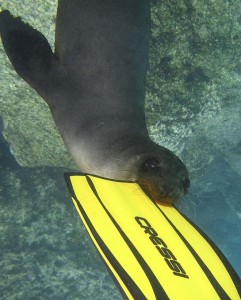 For any diver, the dream of diving the Galapagos Islands is very high on the bucket list. Having watched so many documentaries on this place, Annika and I were very excited to sail into the islands to see for ourselves the mega fauna that gives the place its unbelievable reputation.
For any diver, the dream of diving the Galapagos Islands is very high on the bucket list. Having watched so many documentaries on this place, Annika and I were very excited to sail into the islands to see for ourselves the mega fauna that gives the place its unbelievable reputation.
The islands became known as the ‘Enchanted Isles’ when they were discovered by mistake in 1534 when the Dominican Bishop, Fray Tomas de Berlanga, strayed from his course whilst heading from Panama to Peru. After leaving the islands, they were extremely hard to find again and hence the name. I can tell you that having sailed from Panama to Galapagos, the currents in the region are very strong heading north-west and with old navigation techniques, these would be very hard to calculate. It wasn’t until Charles Darwin visited the islands in 1835 that the islands would start to grow to what they are today. Tourism is the #1 economic driver in the Galapagos with fishing a close second.
There are two ways to dive the Galapagos. You can dive on day tours from the major islands, or you can take a live-a-board trip. The only way to see the world famous Darwin and Wolf Islands is to go with a live-a-board. Live-a-board vessels have varying days and routes and can range from US$2,000 if you get a last minute deal on the island through to well over US$10,000. If you want to go day diving, then you need to head to Santa Cruz as all the best diving is out of there. We dealt exclusively with Academy Bay Dive Centre in Santa Cruz. The reason was quite simple, they had the best reputation and also supported our cause by offering us a good deal. They can also organise your live-a-board tours and island activities.
Before we go too far, I will say that the diving prices may surprise you at first, however you are diving the Galapagos Islands. A days diving with Academy Bay is US$180 per person for 2 dives. It includes boat transfers, guides, all gear and lunch. Some places will offer you a discount however we found out from other divers, you get what you pay for. If you get offered US$140 then you are going out on a small boat and your dives will be short and the equipment fairly second rate. However the main factor with any diving, but especially with remote locations, is safety. You don’t want to risk things for say $20. The experience we had with Academy Bay was outstanding, and I am not saying that because they supported us, the crew were ultra-friendly, the food matched Annika’s dietary requirements and the guides were excellent in and out of the water. We of course used our own gear, however other divers had no issues with the gear provided to them. If we hadn’t liked the service, we wouldn’t have dived with them, we were happy to pay for the best experience.
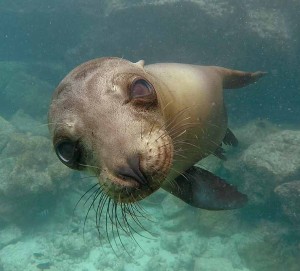 We chose to dive on 4 different days to take in the top spots of the island. They would literally circumference the island, one in the south, one in the west, one in the east and the final dive in the north. Day one and we were meant to go to Floreana, a small southern island where you see turtles and sharks, however the weather was pretty ordinary so we diverted to Santa Fe Island where we would hopefully dive with sea lions. The dive vessel Sea Robins is a 12m flybridge cruiser with a couple of outboards on the back. King Carlos was our skipper every day and whilst he never came down from the flybridge, as a skipper myself, I knew he had his eyes on the entire proceedings at all times. After a rough 45 minute trip we pulled into the lee of the island and then into a small bay where the azure waters met the white sandy beach. All along the Eastern side of the bay was a rocky wall with hundreds of sea lion pups sunning themselves. We got pretty excited about this.
We chose to dive on 4 different days to take in the top spots of the island. They would literally circumference the island, one in the south, one in the west, one in the east and the final dive in the north. Day one and we were meant to go to Floreana, a small southern island where you see turtles and sharks, however the weather was pretty ordinary so we diverted to Santa Fe Island where we would hopefully dive with sea lions. The dive vessel Sea Robins is a 12m flybridge cruiser with a couple of outboards on the back. King Carlos was our skipper every day and whilst he never came down from the flybridge, as a skipper myself, I knew he had his eyes on the entire proceedings at all times. After a rough 45 minute trip we pulled into the lee of the island and then into a small bay where the azure waters met the white sandy beach. All along the Eastern side of the bay was a rocky wall with hundreds of sea lion pups sunning themselves. We got pretty excited about this.
As we entered for our first dive, it was apparent that the ‘dad’ of the group was patrolling the waters edge to make sure they didn’t enter until he approved it. So we swam along and saw him a few times but the pups stayed on the rocks. We decided to look for other cool creatures and found countless giant moray eels and lobsters. Returning to our entry point we hoped the sea lions had come to play however the sun was too nice on the rocks it seems. So after a good long 70 minute dive we exited the water a little disappointed we hadn’t swum with them. And wouldn’t you know it, 5 minutes later they all jumped in the water. I couldn’t resist and went to snorkel with them in between the dives and it was amazing. As you free dived down, they would join you, twisting and turning in ways that a human can’t. They would try and eat your fins, just like they try and eat each other’s hind fins. They tried to eat the GoPro on several occasions too.
It didn’t take long for the rest of our group to join us and we spent probably 45 minutes playing with a group of 10-15 sea lions before they decided they needed a rest, and so did we. We moved further south along the island for our second dive and would go on a hunt for sharks and turtles. The cliff faces were covered in the blue footed boobie birds that are commonly seen in this area. In the water and it was to be one of those days where the mega fauna just didn’t come to play. That’s diving for you I guess, you can’t guarantee anything when it comes to sharks, turtles and rays. We still found plenty of smaller fish, moray eels and lobsters. So we returned to base happy to have had the opportunity to snorkel with the sea lions which was the highlight of the day.
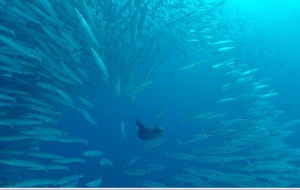 Day two and we would be off to Pinzon Island in the west. This is 1hr45min from Puerto Ayora and most of it was downwind with the waves so I wasn’t looking forward to the return journey. On the northern side of Pinzon is a small bay with a rocky outcrop adjoining. We were to dive into the azure sandy bottomed waters and then swim along the ridge out to the rocky outcrop. Simon, our dive guide for the day explained what we were likely to see and drew a map showing a little bit of professionalism which we liked a lot. Entering the water and straight away I see a large school of barracuda in the middle of the bay and make my way over. After 10 minutes with the school they all start to scatter right in front of me as a large sea lion hunts the pack. It was pretty spectacular and the smile just grew and grew on my face.
Day two and we would be off to Pinzon Island in the west. This is 1hr45min from Puerto Ayora and most of it was downwind with the waves so I wasn’t looking forward to the return journey. On the northern side of Pinzon is a small bay with a rocky outcrop adjoining. We were to dive into the azure sandy bottomed waters and then swim along the ridge out to the rocky outcrop. Simon, our dive guide for the day explained what we were likely to see and drew a map showing a little bit of professionalism which we liked a lot. Entering the water and straight away I see a large school of barracuda in the middle of the bay and make my way over. After 10 minutes with the school they all start to scatter right in front of me as a large sea lion hunts the pack. It was pretty spectacular and the smile just grew and grew on my face.
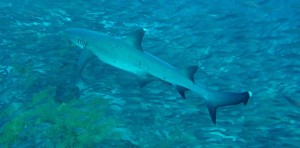 Simon moved us on as there was more to see. Next thing we run into a giant school of black and silver striped saleema fish. It is huge and then they start scattering too, this time as a sizeable white tip reef shark swims through the school. This really did make my day, yet there was plenty more in store. The topography of the rocky outcrop is absolutely stunning. There are fish all over the walls and then the odd turtle appears before you are shot up over the top of a rock with the current. Over the other side Simon directs us to hang onto the rock and there we are, looking out into the deep blue at hundreds of fish swimming in the current. I literally could of sat there all day if given the chance to, it was magical. However a white tip reef shark and a couple of turtles dragged us away.
Simon moved us on as there was more to see. Next thing we run into a giant school of black and silver striped saleema fish. It is huge and then they start scattering too, this time as a sizeable white tip reef shark swims through the school. This really did make my day, yet there was plenty more in store. The topography of the rocky outcrop is absolutely stunning. There are fish all over the walls and then the odd turtle appears before you are shot up over the top of a rock with the current. Over the other side Simon directs us to hang onto the rock and there we are, looking out into the deep blue at hundreds of fish swimming in the current. I literally could of sat there all day if given the chance to, it was magical. However a white tip reef shark and a couple of turtles dragged us away.
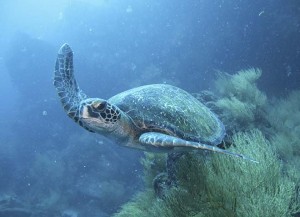 The rest of the dive was swimming from turtle to turtle and taking in the stunning contours of the rocks. Volcanic rock makes the best diving topography it seems. After the dive we are sitting back on the boat and you know it’s a good dive when no one can stop talking about it. For an hour the group reminisces about the dive and then it’s time for dive number two. Having spotted all the major mega fauna expected on the first dive, Simon decided we would go and hunt Manta Rays on the other side of the bay. Visibility started off okay but slowly deteriorated as the current increased. We had two sightings of mantas but both in the distance and neither hung around long enough to capture on camera. The trip back to base was long and arduous however everyone was pretty tired and satisfied with their day of diving.
The rest of the dive was swimming from turtle to turtle and taking in the stunning contours of the rocks. Volcanic rock makes the best diving topography it seems. After the dive we are sitting back on the boat and you know it’s a good dive when no one can stop talking about it. For an hour the group reminisces about the dive and then it’s time for dive number two. Having spotted all the major mega fauna expected on the first dive, Simon decided we would go and hunt Manta Rays on the other side of the bay. Visibility started off okay but slowly deteriorated as the current increased. We had two sightings of mantas but both in the distance and neither hung around long enough to capture on camera. The trip back to base was long and arduous however everyone was pretty tired and satisfied with their day of diving.
The way we had set up our dive days was to go to better and better destinations each day. We wanted to finish on a high. Our third day of diving would be to the famous Gordon Rocks. These small rocks off the east coast of Santa Cruz are famous for one thing and one thing alone……hammerheads. Okay, you aren’t going to see hundreds like up at Wolf and Darwin islands in the north, however there was a good chance to see small schools. It’s not a long distance dive, you literally swim maybe 300m in the entire dive and it is with current. Simon picked the currents perfectly and we dropped in on the southern end between the two main rocks. First up were a couple of small eagle rays. The color of the water is a beautiful blue and we are at 30m with at least 30m visibility. They were stunning. Then the hand signals from the guys ahead in our group start indicating hammerheads. I look up and see 4 swimming around the group back towards me. Annika says they are babies compared to Australia’s hammerheads however seeing 4 at once was new for her.
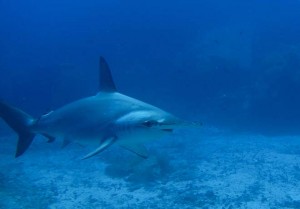 Moving on north in the dive you come to the pinnacles between the two main rocks and there on the floor are three white tip reef sharks resting up for the day before a night out hunting. With mouths opening and closing as they pump water through their gills, their eyes follow you closely as you move ever so slowly, closer and closer. They were happy just to sit there and we didn’t disturb them. Up head the group were now chasing turtles and around the corner one particular turtle was munching on the rocks and as I sat beside him, he moved closer and closer towards me to the point I thought he was going to swim through me. I think he wanted a hug, he was gorgeous. One amusing part of the dive for me was seeing another company enter the water after us, swim past us like it was a race and surface well before us. I felt sorry for their divers, they weren’t getting the dive they wanted. We all know diving is not a race and mega fauna comes to you more when you are still.
Moving on north in the dive you come to the pinnacles between the two main rocks and there on the floor are three white tip reef sharks resting up for the day before a night out hunting. With mouths opening and closing as they pump water through their gills, their eyes follow you closely as you move ever so slowly, closer and closer. They were happy just to sit there and we didn’t disturb them. Up head the group were now chasing turtles and around the corner one particular turtle was munching on the rocks and as I sat beside him, he moved closer and closer towards me to the point I thought he was going to swim through me. I think he wanted a hug, he was gorgeous. One amusing part of the dive for me was seeing another company enter the water after us, swim past us like it was a race and surface well before us. I felt sorry for their divers, they weren’t getting the dive they wanted. We all know diving is not a race and mega fauna comes to you more when you are still.
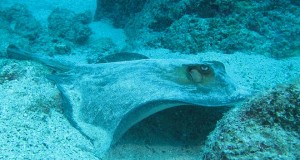 On the boat and the group is chatting about their sightings. Our second dive would be from north to south on the other side of the gap between the rocks. I sat back from the group a little at first as I was taking footage of a turtle and shark. As I swam slowly after the group the hand signals are firing off again for hammerheads. Then the biggest hammerhead we would see swims around behind the group and between me and Annika. At 2m, it was awesome. Such a majestic creature. The rest of the dive was amazing with more hammerheads and white tip reef sharks, turtles and rays. This is what we had come to the Galapagos for and we finished it all off with some sea lions. If you had a tick list, then the only things missing were manta rays and whale sharks, however it wasn’t really season for these guys.
On the boat and the group is chatting about their sightings. Our second dive would be from north to south on the other side of the gap between the rocks. I sat back from the group a little at first as I was taking footage of a turtle and shark. As I swam slowly after the group the hand signals are firing off again for hammerheads. Then the biggest hammerhead we would see swims around behind the group and between me and Annika. At 2m, it was awesome. Such a majestic creature. The rest of the dive was amazing with more hammerheads and white tip reef sharks, turtles and rays. This is what we had come to the Galapagos for and we finished it all off with some sea lions. If you had a tick list, then the only things missing were manta rays and whale sharks, however it wasn’t really season for these guys.
We didn’t actually go back to base that night, we went 20 minutes north to Baltra Island, which is where the airport is. We got off there and were transferred by car back to Puerto Ayora. It had been a magic day, one that neither of us will ever forget. Simon was king of the mega fauna.
We took a 6 day break from diving to go and see Isla Isabela before our next dive which would be up at Seymour Island. If you go to Isabela, make sure you snorkel the tunnels. It is a tour and your snorkel guide will show you white tips reef sharks, turtles, sea horses, penguins and more as well as some of the most stunning land based scenery you will see anywhere in your life. Also check out Sierra Negra and Chico Volcanos on the Volcano tour. These are highlights of the Galapagos.
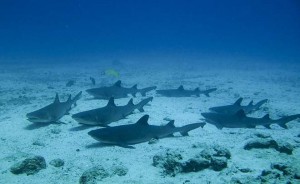 Our final dive in the Galapagos would be Seymour. It is an all-round dive site where you can see everything you want. Our first dive was on North Seymour and when you swim up to seven white tip reef sharks all resting on the bottom, it’s a good way to start a dive. I would lose count of how many sharks we would see and whilst we didn’t see them ourselves, the other group of divers from our boat saw 20 hammerheads swim past them in the deep blue. It’s a shame we missed it but that’s diving. A spotted eagle ray swam around our group for a while and the puffer fish are everywhere and quite curious. In fact one of them swam onto of my Go-Pro stick as I filmed the eagle ray and then when I stopped swimming, he swam around the front of the camera and tried to eat it. It is classic footage that you can see on our website.
Our final dive in the Galapagos would be Seymour. It is an all-round dive site where you can see everything you want. Our first dive was on North Seymour and when you swim up to seven white tip reef sharks all resting on the bottom, it’s a good way to start a dive. I would lose count of how many sharks we would see and whilst we didn’t see them ourselves, the other group of divers from our boat saw 20 hammerheads swim past them in the deep blue. It’s a shame we missed it but that’s diving. A spotted eagle ray swam around our group for a while and the puffer fish are everywhere and quite curious. In fact one of them swam onto of my Go-Pro stick as I filmed the eagle ray and then when I stopped swimming, he swam around the front of the camera and tried to eat it. It is classic footage that you can see on our website.
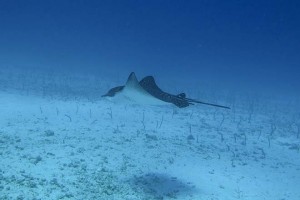 In between dives we anchored in shallow waters off a white sandy beach and watched sea lions playing and two manta rays feeding in the shallows. They were a bit too far away to dive in and snorkel with on this occasion. Our second dive was between Seymour and Mosquera and was a repeat of the first with lots of sharks basking on the sandy bottom, a few more rays and we even had a few hammerheads, although I didn’t see them. We also saw the smallest two tone blue nudibranch which was beautiful in color. I had a deal going with Simon that he had to guarantee me hammerheads on my final dive. Being Australian, it was a beer bet. He owed me a beer if I didn’t see them and I owed him a beer for everyone I saw. Right through the dive, he would see them and I’d be off looking at something else and at the end of the dive we are up at our safety stop and then all of a sudden Simon is madly pointing to me and there below me was the tiniest little hammerhead I’ve ever seen. It was quite amusing back on the surface, he was so happy. I asked him if I owed him a tiny little beer?
In between dives we anchored in shallow waters off a white sandy beach and watched sea lions playing and two manta rays feeding in the shallows. They were a bit too far away to dive in and snorkel with on this occasion. Our second dive was between Seymour and Mosquera and was a repeat of the first with lots of sharks basking on the sandy bottom, a few more rays and we even had a few hammerheads, although I didn’t see them. We also saw the smallest two tone blue nudibranch which was beautiful in color. I had a deal going with Simon that he had to guarantee me hammerheads on my final dive. Being Australian, it was a beer bet. He owed me a beer if I didn’t see them and I owed him a beer for everyone I saw. Right through the dive, he would see them and I’d be off looking at something else and at the end of the dive we are up at our safety stop and then all of a sudden Simon is madly pointing to me and there below me was the tiniest little hammerhead I’ve ever seen. It was quite amusing back on the surface, he was so happy. I asked him if I owed him a tiny little beer?
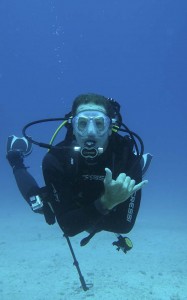 When you think of the Galapagos you think of the mega fauna and hammerheads are at the top of that list. We came in December which is a little after Whale Shark season however the waters were warm at 26 degrees due to it being in an El Nino period and even with the cloudy days, the diving was absolutely everything we wanted and more. Alice at Academy bay was honest when we enquired about the live-a-boards and told us they hadn’t been seeing the whale sharks and as many hammerheads as normal up at Darwin & Wolf due to the El Nino and hence why we opted for the day tours. We will surely return one day when it is not El Nino to dive Darwin & Wolf.
When you think of the Galapagos you think of the mega fauna and hammerheads are at the top of that list. We came in December which is a little after Whale Shark season however the waters were warm at 26 degrees due to it being in an El Nino period and even with the cloudy days, the diving was absolutely everything we wanted and more. Alice at Academy bay was honest when we enquired about the live-a-boards and told us they hadn’t been seeing the whale sharks and as many hammerheads as normal up at Darwin & Wolf due to the El Nino and hence why we opted for the day tours. We will surely return one day when it is not El Nino to dive Darwin & Wolf.
Ocean Crusaders diving adventures are sponsored by Cressi and LED Dive Lights Australia. Without their amazing support we wouldn’t be able to capture the footage required for our online education program to educate youth of the issues our oceans are facing with regards to plastic pollution. Visit www.OceanCrusaders.org for more details on our crusades and to find additional photos from our diving and sailing adventures.
[cincopa AcFAgItQorbK]